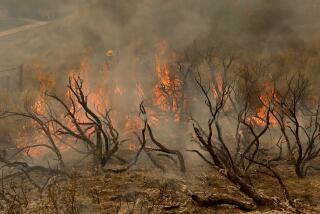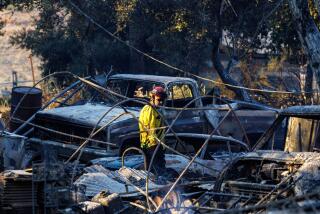Driven by wind, catastrophe sweeps across three counties
In a swiftly moving catastrophe that seemed as familiar as it was shocking, Southern California once again was besieged by flame Saturday, from Orange County to Santa Barbara, with hundreds of homes consumed by three major wind-driven fires, including one of the most devastating blazes ever to strike the city of Los Angeles.
At least 30,000 people were ordered to evacuate their homes amid smoke that blew like stinging fog through wind-ravaged canyons. Major freeways, including Interstate 5 and the 91 and 71 freeways, were closed, making escape tricky for some. More than 500 mobile homes were destroyed at a community in Sylmar; and about 100 houses and apartments were damaged or destroyed in Riverside and Orange counties. The numbers were expected to grow.
Authorities focused overnight on flames rapidly pushing northwest through Chino Hills State Park, where they posed a threat to neighborhoods in Carbon Canyon and Chino Hills. Officials ordered evacuations in the area.
Remarkably, there was no new loss of life reported. On Friday, a 98-year-old man died while being evacuated in Santa Barbara, where fire destroyed multimillion-dollar homes. There were at least 11 injuries reported Saturday, including four firefighters in Riverside County who were briefly overtaken by flames, and five firefighters were injured in Sylmar.
It was a day of record heat and low humidity throughout the region, with a high of 93 in downtown Los Angeles. A wind advisory remained in effect for portions of the region through this morning.
Fire erupted at about 9 a.m. in Corona, in Riverside County. Dubbed the Freeway Complex fire -- it started near the westbound 91 Freeway not far from the 71 Freeway -- the blaze damaged or destroyed 16 homes in Corona before following the Santa Ana Canyon into Orange County. It destroyed or damaged at least 30 homes in Yorba Linda, then spread to Anaheim Hills, igniting at least 10 homes and 50 apartments. By nightfall, it had scorched nearly 6,000 acres and was just 5% contained.
“The embers are falling miles ahead of the fire front,” said Kris Concepcion, a battalion chief with the Orange County Fire Authority. “That’s what is creating a lot of the problems, and the wind is a challenge.”
One of those fires swept through the Cascade Apartments near Santa Ana Canyon Road in Anaheim Hills, a 250-unit complex set into a hillside, where apartments rent for as much as $2,000 a month.
By Saturday afternoon, a thick layer of smoke hung over the apartments. One resident huffed and puffed as he marched through it.
“I gotta get my dog out,” he growled, without interrupting his stride. Wearing flip-flops, he slogged through puddles left by fire hoses and vanished into the haze.
Firefighter Patrick Ochoa, a veteran of numerous major fires in Southern California who was among the first responders to the Freeway Complex fire, said he could recall no fire as difficult to fight.
“Nothing has been as devastating in O.C. as this,” he said. “This is horrendous.”
In Yorba Linda, wind-driven embers ignited at least five homes on one block of San Antonio Road, and firefighters were struggling to keep the fire east of Fairmont Boulevard, which divides Yorba Linda roughly in half. Streets struck particularly hard by the fire included Hidden Hills Road, Mission Hills Lane and Stonehaven Drive.
A separate fire a few miles north in Brea severely damaged Brea Canyon High School, a continuation school.
More than 20,000 people were ordered to evacuate the Orange County burn area, sometimes under treacherous conditions. Bobby Johnson, 18, of Yorba Linda left on the 57 Freeway, driving through fire on both sides of the road. “It was a valley of flame,” he said.
Portions of the 91, 71 and 55 freeways and the 241 toll road were closed, as were freeways in Los Angeles County, including portions of Interstate 5 and the 14 and 210 freeways.
The fire in Sylmar, known as the Sayre fire, began late Friday night and swept through the Oakridge Mobile Home Park, parts of which had burned after the 1992 Northridge earthquake. The toll appeared to be the largest number of housing units lost to fire in the city of Los Angeles, surpassing the 484 residences destroyed in the 1961 Bel-Air fire.
On Saturday, Oakridge was a broad panorama of ash and twisted metal. Broken water lines gushed and sprayed like artesian wells.
When Fernando Corral, 44, decided to return to his family’s mobile home community, he knew exactly where to go. Standing about 200 yards from the main entrance and leaning against a small chain-link fence, Corral, his wife, and son Jonathan, 13, looked directly at their destroyed home.
“Pretty, isn’t it?” he asked as he turned his head away from the blowing ash. A few feet away lay a charred piano songbook, “Beautiful Dreamer.”
“I never liked that song,” Jonathan Corral said. “It was too hard.”
Some 10,000 people were evacuated overnight, and late Saturday morning their worst fears were realized during a briefing at Sylmar High School by the Los Angeles Fire Department: The fire had begun at 10:30 p.m. Friday, cause unknown. It had spread over some 3,000 acres. There was no containment and, with temperatures rising into the 90s and wind gusts of about 50 mph, the flames were spreading with “great devastation,” said fire Capt. Steve Ruda. Many in the room had watched TV coverage that vividly depicted the windblown firestorm.
“The television,” Ruda said, “does not do justice to what firefighters are dealing with.”
Firefighters later began to contain the fire, which had spread to 8,000 acres by Saturday evening. They described it as a blaze of unusual ferocity.
“I’ve been on 31 years in the city of Los Angeles and have not seen anything like this,” said Michael Bowman, a battalion chief for the Los Angeles Fire Department. He described the scene at the mobile home park at 2 a.m., when firefighters were rousting people from their beds to evacuate in the midst of the firestorm. Bowman said he and three other people found a 300-pound disabled woman, trapped in her home.
“Between the four of us, we were able to take the woman out of the house as fire was breaking the glass,” Bowman said.
He demurred when asked whether arson was the cause.
“We don’t know what actually happened here,” he said.
The Los Angeles Police Department said it had made five arrests in the fire zone, at least two of them on charges of looting, but none that were related to arson. “We’re not aware of anyone being questioned about the cause of the fire,” said Capt. John Incontro.
By Saturday afternoon, residents were returning to survey the damage by trudging down a dusty trail and peering over a four-foot wall into the mobile home park. City Councilman Richard Alarcon, who represents the area, was at the wall, talking to constituents. He shook his head. “I never had a fire chief come up to me and apologize with tears in his eyes before. He said, ‘We stayed as long as we could. We did everything we could.’ ”
Added Alarcon: “I have the highest number of mobile homes in the city in my district -- at least I did before this fire.”
The fire affected electrical transmission lines carrying power over the Newhall Pass. For about 45 minutes Saturday morning, the Los Angeles Department of Water and Power imposed rolling blackouts through portions of the city to cope with a reduced electrical supply.
Earlier, Olive View-UCLA Medical Center in Sylmar, which sustained some fire damage, suffered a crippling power shortage that forced the hospital to quickly evacuate 18 critically ill infants and nine other patients.
Olive View relies on three sources of power -- the main line from DWP, an on-site power plant and a backup generator. All of them failed in quick succession, for apparently unrelated reasons, beginning about 2 a.m. officials said.
The fire caused no damage to the hospital’s main building, but some surrounding property was destroyed, including a garage, two ambulances, and several trailers housing medical and finance records.
Early Saturday, Gov. Arnold Schwarzenegger toured burned areas above Santa Barbara, where the Tea fire had destroyed 111 homes and continued to threaten 1,500 others. It was 40% contained by Saturday evening.
“When you walk around the area that was destroyed, it looks like hell,” Schwarzenegger said after his tour, speaking to reporters at the Earl Warren Showgrounds.
“I feel awful for the people whose homes were destroyed.”
He declared a state of emergency in Los Angeles and Orange counties, adding to his previous declaration for Santa Barbara County.
--
mike.anton@latimes.com
mitchell.landsberg@latimes.com
Contributing to this report were Times staff writers Tami Abdollah, Esmeralda Bermudez, Andrew Blankstein, Ari B. Bloomekatz, Bettina Boxall, Rich Connell, Jason Felch, Christopher Goffard, Scott Gold, Jeff Gottlieb, Corina Knoll, Rong-Gong Lin II, Alicia Lozano, Seema Mehta, Brady MacDonald, Nathan Olivarez-Giles, Bob Pool, Margot Roosevelt, Catherine Saillant, Jason Song, Garrett Therolf, My-Thuan Tran, James Wagner, Dan Weikel, Ruben Vives, Kimi Yoshino and Alexandra Zavis.
--
(BEGIN TEXT OF INFOBOX)
Where to call for information
* Insurance Commissioner Steve Poizner says some expenses incurred during a mandatory evacuation, such as hotel stays and meals, are covered by some homeowner insurance policies. Evacuees should check their policies and can contact the Department of Insurance: (800) 927-HELP
* The city of Los Angeles has set up an information hotline on the Sayre fire: (800) 439-2909
* Red Cross emergency assistance: (888) 737-4306
* Los Angeles Mayor Antonio Villaraigosa said that he was interested in providing permanent housing for some low-income residents who lost their homes; formal plan is not in place.
* Dial 211 to connect with community services, such as child care, counseling, food and shelter. The service is available in most counties.
* The Los Angeles County Department of Mental Health said it would offer free crisis counseling for victims of the Sayre fire beginning Monday. For information: (818) 832-2400 or (818) 598-6900. The department’s Access Center can also be reached 24 hours a day: (800) 854-7771
* For information on resources available for small businesses affected by the fire: (800) 659-2955
Source: Times research
More to Read
Sign up for Essential California
The most important California stories and recommendations in your inbox every morning.
You may occasionally receive promotional content from the Los Angeles Times.











